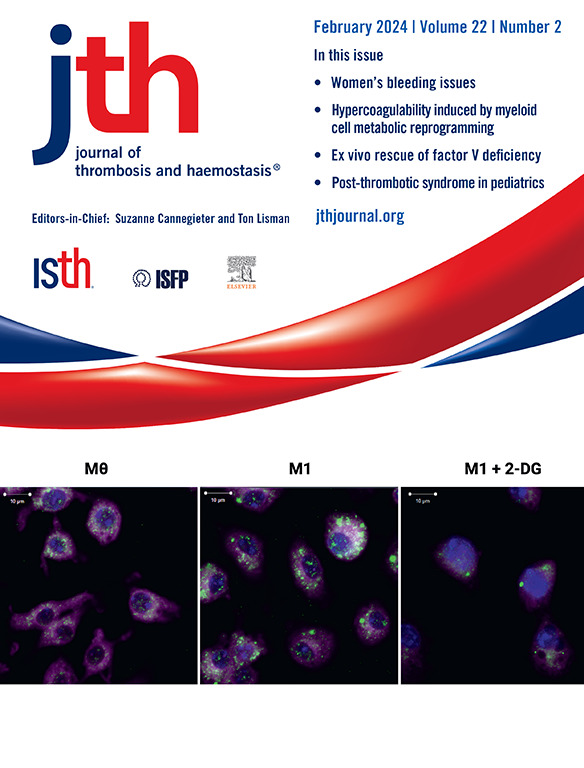Impact of streptozotocin-induced hyperglycemia on the host response to sepsis
IF 5
2区 医学
Q1 HEMATOLOGY
引用次数: 0
Abstract
Background
Diabetes is a common comorbidity in patients with sepsis, yet the influence of baseline glycemic status on sepsis outcomes remains unclear. Clinical studies report conflicting associations between diabetes and sepsis mortality.
Objectives
To evaluate how short-term (ie, 4-5 weeks) preinfection hyperglycemia influences the host response to sepsis using a model of fecal-induced peritonitis.
Methods
Hyperglycemia was induced in C57BL/6 mice (both sexes) via streptozotocin injections. Hyperglycemic and normoglycemic mice were subjected to fecal-induced peritonitis, with endpoints at 8 hours and 48 hours postinfection. Blood glucose, insulin, advanced glycation end-products, cytokines (interleukins 6 and 10), coagulation markers (thrombin-antithrombin and protein C), cell-free DNA (cfDNA), lung myeloperoxidase, bacterial loads, organ injury, and survival were assessed.
Results
Streptozotocin-treated mice exhibited low insulin and elevated blood glucose, advanced glycation end-products, thrombin-antithrombin, and cfDNA compared with normoglycemic mice. Despite these baseline differences, the trajectory of sepsis was similar in both groups. Blood glucose rapidly dropped postinfection, converging at approximately 2 mM within 12 hours in nonsurvivors and partially recovering in survivors. Plasma insulin increased in both groups in response to sepsis, returning to baseline levels by 48 hours in survivors. No significant differences were found between the groups in sepsis-related outcomes, including sepsis scores, body temperature, inflammatory and coagulation responses, cfDNA, lung myeloperoxidase, bacterial burden, organ injury, or survival.
Conclusion
Short-term hyperglycemia did not alter the course of sepsis compared with normoglycemic mice. Blood glucose levels partially recovered in surviving mice, suggesting that restoring glucose homeostasis may improve outcomes.
链脲佐菌素(STZ)诱导的高血糖对宿主败血症反应的影响。
糖尿病是脓毒症患者的常见合并症,但基线血糖状态对脓毒症结局的影响尚不清楚。临床研究报告了糖尿病和败血症死亡率之间相互矛盾的关联。目的:评估短期(即。4至5周)感染前高血糖影响宿主对脓毒症的反应,使用粪便性腹膜炎(FIP)模型。方法:采用链脲佐菌素(STZ)诱导C57BL/6小鼠(两性)高血糖。在感染后8小时和48小时对高血糖和正常血糖小鼠进行FIP治疗。评估血糖、胰岛素、晚期糖基化终产物(AGE)、细胞因子(IL-6、IL-10)、凝血标志物(TAT、蛋白C)、无细胞DNA (cfDNA)、肺髓过氧化物酶(MPO)、细菌负荷、器官损伤和生存率。结果:与血糖正常的小鼠相比,stz治疗小鼠表现出低胰岛素和升高的血糖、AGE、TAT和cfDNA。尽管存在这些基线差异,但两组败血症的发展轨迹相似。感染后血糖迅速下降,非幸存者在12小时内收敛到2 mM,幸存者部分恢复。脓毒症后,两组患者血浆胰岛素均升高,存活患者在48小时后恢复到基线水平。脓毒症相关结果,包括脓毒症评分、体温、炎症和凝血反应、cfDNA、肺MPO、细菌负担、器官损伤或生存率,在两组之间没有发现显著差异。结论:与血糖正常的小鼠相比,短期高血糖没有改变脓毒症的病程。存活小鼠的血糖水平部分恢复,表明恢复葡萄糖稳态可能改善预后。
本文章由计算机程序翻译,如有差异,请以英文原文为准。
求助全文
约1分钟内获得全文
求助全文
来源期刊
CiteScore
24.30
自引率
3.80%
发文量
321
审稿时长
1 months
期刊介绍:
The Journal of Thrombosis and Haemostasis (JTH) serves as the official journal of the International Society on Thrombosis and Haemostasis. It is dedicated to advancing science related to thrombosis, bleeding disorders, and vascular biology through the dissemination and exchange of information and ideas within the global research community.
Types of Publications:
The journal publishes a variety of content, including:
Original research reports
State-of-the-art reviews
Brief reports
Case reports
Invited commentaries on publications in the Journal
Forum articles
Correspondence
Announcements
Scope of Contributions:
Editors invite contributions from both fundamental and clinical domains. These include:
Basic manuscripts on blood coagulation and fibrinolysis
Studies on proteins and reactions related to thrombosis and haemostasis
Research on blood platelets and their interactions with other biological systems, such as the vessel wall, blood cells, and invading organisms
Clinical manuscripts covering various topics including venous thrombosis, arterial disease, hemophilia, bleeding disorders, and platelet diseases
Clinical manuscripts may encompass etiology, diagnostics, prognosis, prevention, and treatment strategies.

 求助内容:
求助内容: 应助结果提醒方式:
应助结果提醒方式:


